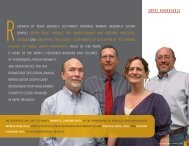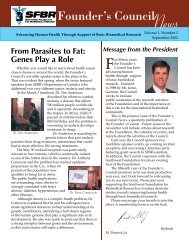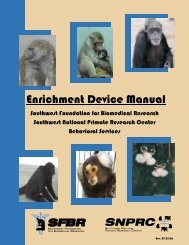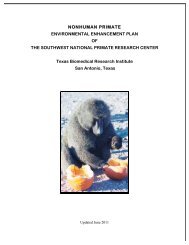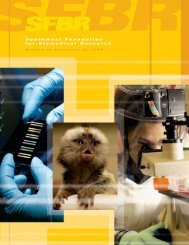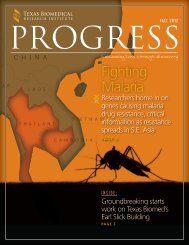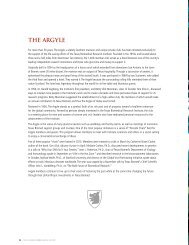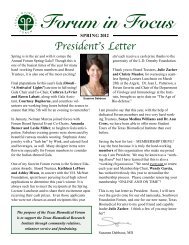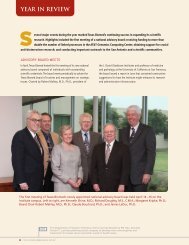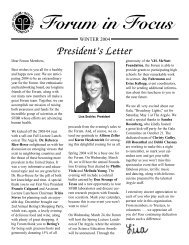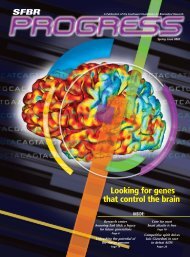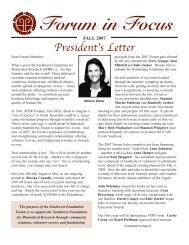Vol. 8 No. 2, 2011 [PDF] - Texas Biomedical Research Institute
Vol. 8 No. 2, 2011 [PDF] - Texas Biomedical Research Institute
Vol. 8 No. 2, 2011 [PDF] - Texas Biomedical Research Institute
- No tags were found...
You also want an ePaper? Increase the reach of your titles
YUMPU automatically turns print PDFs into web optimized ePapers that Google loves.
Improving Quality of Life by Studying Fetal Development<br />
Peter Nathanielsz, M.D., Ph.D., has been investigating<br />
the connection between in utero development and health<br />
throughout the lifespan since the 1970s. Working on the<br />
premise that developmental programming creates the<br />
landscape in which you will live the rest of your life, he<br />
has examined the effect of maternal undernutrition and<br />
overnutrition on offspring, and how normal and elevated levels<br />
of the stress hormone, cortisol, affect fetal development. He<br />
began to pursue these current lines of research in 2002, with<br />
funding from a National <strong>Institute</strong>s of Health program project<br />
grant (“Nutrient Restriction,” P01 HD021350).<br />
While the role of developmental programming has been<br />
discussed with increasing frequency in the popular press,<br />
Nathanielsz worries that not enough context is presented to<br />
empower women and families to make informed choices. “The<br />
way I work scientifically is that I first try to ask a question<br />
and then seek hard scientific data to answer it. What are the<br />
potential later life health problems for children of overweight<br />
and obese mothers What are the consequences to children<br />
when their mothers are exposed to excessive amounts of stress<br />
The Round-Up<br />
Director’s Letter<br />
On February 1, <strong>2011</strong>, the name<br />
of SNPRC’s host institution<br />
was changed from Southwest<br />
Foundation for <strong>Biomedical</strong><br />
<strong>Research</strong> to <strong>Texas</strong> <strong>Biomedical</strong><br />
<strong>Research</strong> <strong>Institute</strong>. This name<br />
change coincides with the<br />
initiation of efforts to implement a<br />
recently completed campus master<br />
plan in which the construction of<br />
new buildings for the SNPRC is<br />
prominently featured. The new buildings will provide stateof-the-art<br />
laboratories for SNPRC scientists and will enable an<br />
increase in staff and an expansion of research activities within<br />
in pregnancy” Nathanielsz and others in<br />
this field have been accused of making<br />
women feel guilty. But, he notes “Women<br />
aren’t the only ones involved in pregnancy;<br />
in reality the whole of society has a<br />
responsibility to understand the biology of<br />
pregnancy and how to improve outcomes<br />
and avoid problems. We are talking about<br />
biology, not blame or fault.” The nine months of gestation are<br />
so critical because “What happens in the womb determines the<br />
rate at which you age, your response to stress, your response<br />
to food intake, your predisposition to obesity, diabetes,<br />
cardiovascular disease.”<br />
This approach has led Nathanielsz to examine the longterm<br />
impact of synthetic glucocorticoids given to women<br />
in premature labor. The hormone crosses the placental<br />
barrier and accelerates the development of the fetal lungs,<br />
ripening them in preparation for taking the first breath after<br />
birth. This treatment has been used to save thousands of<br />
lives since 1973, when G.C. Liggins in New Zealand first<br />
(Continued on page 8)<br />
In this Issue<br />
(Continued on page 4)<br />
the Center. As the campus master plan was being finalized,<br />
several major renovation projects were initiated to improve<br />
our primate group housing and to expand cage space for<br />
experimental work.<br />
Baboons.--Group housing is being improved by<br />
the renovation of the walls of the B and E cage complexes<br />
(29,340 sq.<br />
ft.), under funding<br />
($467,000) from an<br />
NCRR G20 grant.<br />
These cages house<br />
approximately 725<br />
baboons from our<br />
pedigreed breeding<br />
colony.<br />
2 Teacher Enrichment Initiative<br />
3 Staff Focus<br />
5 Summer Interns<br />
6 News Round Up<br />
8 <strong>No</strong>tices
2<br />
<strong>Vol</strong>ume 8, <strong>No</strong>. 2, <strong>2011</strong><br />
Teacher Enrichment Initiatives Update<br />
Some area high school science teachers who visited SNPRC<br />
this summer to learn about the role of animals in biomedical<br />
research have found a fun way to enrich the lives of our<br />
chimpanzees. Using funds from the TEI program at UTHSCSA,<br />
teachers at New Braunfels High School and Pearsall High<br />
Scholl created piñatas for the animals this fall. The piñatas<br />
will be filled with nutritious food enrichment at SNPRC and<br />
provided to the animals as a fun treat. The goal with this project<br />
is to “give teachers and students an appreciation for the work<br />
we do to ensure the psychological well-being of our nonhuman<br />
primates who participate in biomedical research conducted at<br />
the SNPRC,” says Corrine Lutz, the head of the Behavioral<br />
Services group.<br />
An East Central ISD student creates a piñata.<br />
HOW TO MAKE A PIÑATA<br />
Chimpanzees enjoy tearing apart the piñata almost as much as<br />
they enjoy eating the seeds and other treats inside.<br />
The Round-Up<br />
is published twice a year by the Southwest<br />
National Primate <strong>Research</strong> Center.<br />
John L. VandeBerg, Director<br />
P.O. Box 760549, San Antonio, <strong>Texas</strong> 78245-0549<br />
Phone: 210-258-9780 Fax: 210-258-9883 http://www.snprc.org<br />
This newsletter provides updates on scientific research and activities<br />
supported by the National Center for <strong>Research</strong> Resources, National <strong>Institute</strong>s<br />
of Health. We welcome inquiries about our biomedical research program and<br />
collaborative opportunities for outside investigators.<br />
April Hopstetter, Editor Copyright <strong>2011</strong><br />
Ph: 210-258-9519<br />
Southwest National Primate <strong>Research</strong> Center<br />
Fax: 210-258-9863<br />
E-mail: ahopstet@TxBiomed.org<br />
1. Cut butcher paper into 1 ½ inch strips<br />
2. Fill tub with water<br />
3. Add flour and mix until thick<br />
4. Blow up and tie balloons<br />
5. Use plastic containers as stands for balloons<br />
6. Soak paper strips in tub and coat them<br />
thoroughly with flour water mixture<br />
7. Layer strips of paper around balloon<br />
8. Add 2 layers of paper strips<br />
9. Store on containers over night, or until dry and<br />
hard<br />
HOW TO PAINT A PIÑATA<br />
1. Paint solid base coat with any color non-toxic<br />
paint<br />
2. Allow to dry<br />
3. Use multi-colored paints to create various<br />
designs<br />
4. Allow to dry, placing piñata on a plastic or<br />
cardboard container<br />
5. Balloons will shrink over time and pull away<br />
from the paper<br />
6. Finished piñatas may be stored and transported<br />
in large plastic trash bags
The Round-Up 3<br />
Staff Focus: Jera Pecotte, Ph.D.<br />
Jera Pecotte, Ph.D., fulfills many roles in<br />
the SNPRC. She oversees the biomaterials<br />
distribution program and a variety of training and<br />
internship programs. Dr. Pecotte began her career<br />
working in forensic anthropology, providing<br />
support to the Utah State Medical Examiner’s<br />
office. She also worked with ancient Egyptian<br />
remains both in Italy and Egypt. After several<br />
years in Italy directing a U.S. consortium studyabroad<br />
program at the University of Turin, she<br />
returned to the U.S., where friend and colleague<br />
Karen Rice, Ph.D., recruited her to oversee the<br />
burgeoning biomaterials program at SNPRC.<br />
Pecotte was able to use her background in<br />
anatomy immediately. What started as an interim<br />
position has grown over the intervening eight<br />
years. She took over the tissue collection role,<br />
which had begun under the guidance of Henry<br />
McGill, M.D., and expanded over time, and now also oversees<br />
the blood and DNA repository.<br />
Her staff includes Kelly Clark, <strong>Research</strong> Technician II, who<br />
is in charge of order shipping and assists with some tissue<br />
collection; Leilah Minica, Senior <strong>Research</strong> Assistant, who is<br />
in charge of DNA extraction and other “wet lab” work; and<br />
Steve Rios, <strong>Research</strong> Techician III, who is in charge of blood<br />
processing and tissue collection at necropsy. The biomaterials<br />
team ensures that samples are correctly collected, stored or<br />
shipped according to investigator request. Biomaterials works<br />
hand-in-hand with the Pathology group, which often processes<br />
tissues in house for the investigator. Pecotte has also recruited<br />
the assistance of a neuroanatomist consultant from UTSA, Dr.<br />
Clyde Phelix, to dissect out precise brain tissues at necropsy for<br />
complex specialized requests.<br />
Pecotte hopes to continue to increase and diversify the offerings<br />
of the biomaterials service, suggesting that creating RNA on<br />
request, creating RNA assays, or other innovative services,<br />
may be possible. Pecotte interacts with others who maintain<br />
primate repositories and also with the International Society<br />
for Biological and Environmental Repositories, where she can<br />
research practical issues such as best methods for maintaining<br />
inventory, the best receptacles for samples, and optimizing<br />
storage and handling conditions.<br />
Pecotte finds recipients to be very appreciative. “We’ve had offsite<br />
investigators come to visit us to thank us for making their<br />
studies possible. It’s very rewarding.” She is happy to report that,<br />
in most cases, most requests can be fulfilled. They try to ensure<br />
Biomaterials Services Staff (left to right): Jera Pecotte, Steve<br />
Rios, Leilah Minica, and Kelly Clark.<br />
that samples are collected whenever an opportunity arises.<br />
“The effort of maintaining the resource really pays off when<br />
you see someone who is able to do the research they would<br />
not be able to do otherwise. It’s especially true with tissues<br />
from chimpanzees, whose numbers are dwindling in research<br />
environments as well as in the wild. And the fact that we have<br />
pedigrees makes the samples even more valuable,” Pecotte<br />
says.<br />
As the coordinator of the 2010 summer internship program,<br />
Pecotte had undergraduate and graduate students interact<br />
with high school teachers who were on site to learn about<br />
biomedical research using nonhuman primates. As a result of<br />
these interactions, Pecotte says, “The student interns shared<br />
with the teachers what it was in their education that propelled<br />
them into science. And the high school teachers were really<br />
inspiring. Our role in participating with the science teachers<br />
is to help share and teach the value of animals in biomedical<br />
research. Several of our SNPRC core staff gave talks, our<br />
enrichment staff demonstrated behavior and enrichment tasks,<br />
and we also had a member of our Quality Assurance staff<br />
discuss animal welfare regulations governing research.”<br />
“The high school science teachers also had students create<br />
piñatas for the animals that would be filled with food and<br />
other enrichment items at the SNPRC. That allows the<br />
students be part of the process and perhaps be inspired to<br />
pursue careers in research,” Pecotte concludes.
4<br />
<strong>Vol</strong>ume 8, <strong>No</strong>. 2, <strong>2011</strong><br />
Fetal Development (continued from page 1)<br />
reported that prematurely born lambs whose mothers were given<br />
glucocorticoids had better ability to breathe and survive than<br />
untreated animals.<br />
Nathanielsz has reservations about the far-reaching effects<br />
of glucocorticoid administration. “<strong>No</strong> one has done a trial to<br />
determine the optimal dose. I am concerned with the effects<br />
on the kidney, the brain…seeing high levels of glucocorticoid<br />
before they should. Perhaps a lower dose can allow the lungs to<br />
be prepared for breathing while not prematurely signaling the<br />
other organs to differentiate. My thesis, and I’m certainly not<br />
alone, is that you could get adequate lung maturation if you give<br />
a lower dose. And you would also have less of the potentially<br />
harmful effects on the brain, the kidney, the gut, and the heart.”<br />
The benefit conferred by the dose of steroid lasts for a week;<br />
if labor is delayed beyond a week, no benefit is seen. As a<br />
result, physicians sometimes feel compelled to give additional<br />
doses as pregnancy progresses if it appears that the mother<br />
might still deliver prematurely. Though the NIH does not<br />
endorse administering more than one dose, some women<br />
at risk of preterm delivery do get multiple weekly doses of<br />
glucocorticoids. Even more distressing, in some countries,<br />
giving the steroids to mothers has insinuated itself into the<br />
standard of care even in the absence of any threat of early<br />
delivery. The implications of excessive and unnecessary<br />
exposure of the developing fetus to steroids are serious. When<br />
fetal organs differentiate early following early exposure to<br />
steroids they then have fewer cells and can be more prone to<br />
problems in later life. For example, a smaller pancreas can lead<br />
to diabetes if the diet in later life is not good.<br />
Until a few years ago, there was no evidence of adverse<br />
effects of prenatal glucocorticoid administration on long-term<br />
development in humans. <strong>No</strong>w those babies are adults, and initial<br />
studies have found a higher incidence of glucose instability and<br />
high blood pressure in the first cohorts that received this therapy.<br />
While these findings took 37 years to amass, a primate model<br />
allows researchers to answer scientific questions more quickly:<br />
a baboon reaches puberty in 4 years; a human reaches puberty in<br />
14 years.<br />
Nathanielsz and his team are examining the “cost” of exposure<br />
to high levels of glucocorticoids in fetal life using the baboon as<br />
a model. “In our study, we’re administering the glucocorticoid,<br />
letting the mothers deliver, then we’re looking at the behavior<br />
of the offspring. The three-year-old baboons we are studying<br />
were exposed to high levels of glucocorticoid when in the<br />
womb. We are asking several questions using these offspring.<br />
Has the exposure had any effect on behavior, the pancreas, the<br />
kidney or the gut” Collaborator Mark Nijland, Ph.D., has<br />
Fetal baboon hippocampus stained for microtubular associated protein<br />
2c (MAP2c; brown stain). The hippocampus regulates memory, adrenal<br />
function and many behaviors. Brain tissue from a control late gestation<br />
baboon fetus (left) displays more MAP2c than the hippocampus of a<br />
baboon fetus whose mother received doses of steroids equivalent to<br />
those given in human pregnancy (right).<br />
adapted a behavioral testing system used with young children<br />
to use in the baboon to answer some of these questions, while<br />
SNPRC Core Scientist Laura Cox, Ph.D., is looking at gene<br />
expression to see how it varies between treated and untreated<br />
baboons. Preliminary data indicate that there are differences in<br />
offspring behavior, which are related to sex of the offspring,<br />
at an age equivalent to human adolescence. When studied<br />
in a behavioral test that measures motivation, betamethasone<br />
exposure decreased motivation in both sexes. In a test that<br />
evaluates attention allocation, female offspring exposed to<br />
steroids committed more errors than males. Nathanielsz hopes<br />
these data will help to reopen the dialog with the medical<br />
profession to determine dose of steroid to use to obtain<br />
maximal benefit. “We’ve shown in the pregnant sheep that<br />
half of the dose is adequate for maturing the lungs. Our goal<br />
is not to stop the administration of glucocorticoids to women<br />
threatening to deliver early. This treatment has saved the lives<br />
of countless babies and decreased neonatal problems. But<br />
it is clear that work needs to be done to optimize the dose,”<br />
Nathanielsz says.<br />
“Unless we get firm evidence about the long-term adverse<br />
consequences for normal fetal development of fetal exposure<br />
to glucocorticoids, nothing will change. That’s why we need<br />
sound, careful controlled animal research.” Nathanielsz<br />
concludes.<br />
Peter W. Nathanielsz, M.D., Ph.D., is the Director of the Center for<br />
Pregnancy and Newborn <strong>Research</strong> and Professor in the Department<br />
of Obstetrics and Gynecology, University of <strong>Texas</strong> Health Science<br />
Center, San Antonio.<br />
SELECTED PUBLICATIONS<br />
Nathanielsz PW, Berghorn KA, Derks JB, Giussani DA, Docherty C,<br />
Unno N, Davenport A, Kutzlers M, Koenen S, Visser GH, Nijland<br />
MJ. Life before birth: effects of cortisol on future cardiovascular<br />
and metabolic function. Acta Paediatr. 2003;92(7):766-72.<br />
Nijland MJ. Fetal exposure to corticosteroids: how low can we go J<br />
Physiol. 2003;549(Pt 1):1.<br />
Rodriguez JS, Zürcher NR, Keenan KE, Bartlett TQ, Nathanielsz PW,<br />
Nijland MJ. Prenatal betamethasone exposure has sex specific<br />
effects in reversal learning and attention in juvenile baboons. Am J<br />
Obstet, in press.
The Round-Up 5<br />
Summer 2010 Intern Update<br />
As national resources, the National Primate <strong>Research</strong><br />
Centers are in a unique position to provide training<br />
opportunities to students by providing extensive and varied<br />
opportunities in biomedical research and laboratory animal<br />
care. The need for nonhuman primates in biomedical<br />
research is increasing at a rapid pace as translational research<br />
funding is committed to critical areas such as biodefense,<br />
stem cell development, and gene therapy. This summer’s<br />
students conducted research in virology, immunology,<br />
diseases of aging, and pathology under the guidance of their<br />
SNPRC mentors. The following summarizes each student’s<br />
research.<br />
David Cray, an undergraduate at the University of <strong>No</strong>tre<br />
Dame, worked under the supervision of veterinarians<br />
Heather Cole, D.V.M., Patrice Frost, D.V.M., and Cassie<br />
Bauer, D.V.M. He studied the prevalence and speciation of<br />
Babesia infection in the baboon colony using archived samples.<br />
Drs. Adam Birkenheuer and Anna Stedman of <strong>No</strong>rth Carolina<br />
State University assisted in the genetic identification of Babesia<br />
samples and PCR testing. Future studies may include further<br />
assessment of prevalence and distribution and determination of<br />
the mode of transmission.<br />
Benjamin Fox, an undergraduate at <strong>Texas</strong> A&M University<br />
working toward a degree in biomedical science, worked under<br />
the supervision of pathologists Mike Owston, D.V.M., and<br />
Edward Dick, D.V.M. in the pathology laboratory. He also<br />
worked on a research project, examining 26 years of clinical<br />
records to characterize congenital lesions in baboons. Findings<br />
indicate that the baboon has an incidence of congenital lesions<br />
similar to humans. They will be developed into a manuscript to<br />
be submitted to a peer-reviewed journal.<br />
Antonio Gonzalez, a second-year undergraduate at the<br />
University of Puerto Rico, Mayaguez, worked under the<br />
supervision of Melissa de la Garza, D.V.M. He studied<br />
cardiovascular disease in chimpanzees, examining the<br />
relationship between measures of brain natriuretic peptide (BNP)<br />
and the characteristics of electrocardiograms to see whether BNP<br />
levels correlate to heart health. He found sex-related, but not<br />
weight-related differences in BNP levels, but the small sample<br />
size of 5 animals precluded making definitive conclusions.<br />
BNP levels also seemed to be related to cardiac arrhythmias<br />
and circulatory problems, but seems best suited to serve as a<br />
supplemental metric to use in a diagnostic workup.<br />
Shyamesh Kumar, D.V.M., a graduate student in the College<br />
of Veterinary Medicine of Mississippi State University, worked<br />
under the supervision of Ed Dick, D.V.M. He assisted with<br />
Summer, 2010 Interns and Mentors (left to right): Fabian<br />
Vazquez-Santiago, Shyamesh Kumar, Luis Giavedoni,<br />
Benjamin Fox, Edward Dick, Michael Owston, Antonio<br />
Gonzalez, Cassondra Bauer, David Cray, Melissa de la<br />
Garza, Heather Cole, Ashley Lipps, and Elizabeth Dick<br />
(volunteer).<br />
necropsies and also performed a retrospective investigation<br />
of archived materials to examine cases of encephalitis of<br />
unknown cause in the baboons. He was able to determine<br />
the cause definitively in a majority of cases. Findings will<br />
be developed into a manuscript to be submitted to a peerreviewed<br />
journal.<br />
Ashley Lipps, a third-year graduate student studying<br />
biological anthropology at the University of California,<br />
Berkeley, worked under the supervision of Lorena Havill,<br />
Ph.D. She gathered research data related to her dissertation,<br />
which examines how reproduction reorganizes bone on a<br />
microcellular level. She gathered archived bone samples<br />
from 142 baboon and reviewed the reproductive history of<br />
the females in the pedigreed baboon colony. Analyses are<br />
being completed at Berkeley, but Lipps will return to collect<br />
additional samples later.<br />
Fabian Vazquez-Santiago a first-year graduate student<br />
at Ponce School of Medicine, Puerto Rico, worked under<br />
the supervision of Luis Giavedoni, Ph.D. He broadened<br />
his laboratory experience by constructing viral vectors that<br />
includes “instructions” necessary to generate fusion proteins<br />
that may be used to bind to certain sites on immune system<br />
cells that are targets of SIV, the monkey equivalent of HIV.<br />
The vectors constructed and determined to be functional<br />
as part of this effort will be used to evaluate the macaque’s<br />
immune response to SIV infection.
6<br />
Presentations and Invited Talks at SNPRC<br />
June 2010 - <strong>No</strong>vember 2010<br />
“Hepatitis C and the Chimp Model,” June 29, 2010, Dr.<br />
Robert Lanford, SNPRC Core Scientist, held at the University<br />
of <strong>Texas</strong> Health Science Center<br />
“Trypanosomes and Chagas disease in Ecuador: From basic<br />
research to control interventions,” Thursday, July 8, 2010,<br />
Mauricio Lascano, Ph.D., International Emerging Infectious<br />
Diseases Fellow, Division of Parasitic Diseases, Centers for<br />
Disease Control and Prevention, Atlanta, GA<br />
“Identification of genetic networks underlying cardiovascular<br />
disease phenotypes,” August 13, 2010, Dr. Laura Cox, at the<br />
First Genome <strong>Research</strong> Day, held at the University of <strong>Texas</strong><br />
Health Science Center<br />
“Understanding the genetic and epigenetic complexities of<br />
brain structure and function,” August 19, 2010, Dr. Melanie<br />
Carless, Assistant Scientist, Department of Genetics, SFBR<br />
“Multi-Epitope DNA Vaccines Against Ebola Virus,”<br />
September 7, 2010, Dr. Daniel A. J. Mitchell, Ph.D., U.S.<br />
Army Medical <strong>Research</strong> <strong>Institute</strong> of Infectious Diseases<br />
(USAMRIID), Fort Detrick, Maryland<br />
“Viral Forecasting,” October 15, 2010, Dr. Nathan Wolfe,<br />
Lorry I. Lokey Visiting Professor in Human Biology<br />
at Stanford University and Director of the Global Viral<br />
Forecasting Initiative<br />
“Challenges and opportunities in AIDS vaccine development,”<br />
October 15, 2010, Dr. Wayne C. Koff, Chief Scientific<br />
Officer, Senior Vice President , <strong>Research</strong> and Development ,<br />
International AIDS Vaccine Initiative<br />
“Evolution of splicing in primates,” October 19, 2010, Dr. Yi<br />
Xing, Assistant Professor, Departments of Internal Medicine<br />
and <strong>Biomedical</strong> Engineering, University of Iowa.<br />
“Using Genetics and Stem Cell Therapy to Guide Personalized<br />
Medicine,” October 28, 2010, Dr. Kang Zhang, Professor of<br />
Ophthalmology & Human Genetics, University of California,<br />
San Diego<br />
“Genetics of age-related macular degeneration,” <strong>No</strong>vember<br />
18, 2010, Dr. Peter Francis, Associate Professor, Co-Director,<br />
Oregon Retinal Degeneration Center, Oregon Health &<br />
Science University<br />
<strong>Vol</strong>ume 8, <strong>No</strong>. 2, <strong>2011</strong><br />
Nathan Wolfe visits<br />
SNPRC<br />
On October 14 and 15, 2010,<br />
Dr. Nathan Wolfe, Director of<br />
the Global Viral Forecasting<br />
Initiative (GVFI), visited<br />
the SNPRC. He gave a talk<br />
on “Viral Forecasting” to<br />
an enthusiastic crowd. He<br />
discussed how new methods<br />
of surveillance were being<br />
developed and would be used in<br />
the future to identify emerging<br />
diseases before they became<br />
epidemics.<br />
Dr. Wolfe also met with<br />
SNPRC and SFBR scientists<br />
to discuss future collaborations<br />
utilizing some of the new<br />
epidemiological tools he was developing. The goal of the<br />
trip was to better acquaint Dr.Wolfe with SFBR’s interests<br />
and capabilities as well as introduce SFBR scientists to a new<br />
exotic panel of biologically characterized reagents that Dr.<br />
Wolfe has collected.<br />
According to its web site (www.gvfi.org), “GVFI is a<br />
pandemic early warning system which monitors the spillover<br />
of novel infectious agents from animals into humans. GVFI<br />
coordinates activities of over 100 scientists and staff from<br />
countries around the world. He currently has active research<br />
and public health projects in Cameroon, China, Central African<br />
Republic, DR Congo, PR Congo, Gabon, Equatorial Guinea,<br />
Lao, Madagascar, Malaysia and Sao Tome.”<br />
Tom Folks, Ph.D., Associate Director for <strong>Research</strong> Resources,<br />
SNPRC, along with SFBR, hosted Dr. Wolfe, and notes “Dr.<br />
Wolfe and I have interacted for over 12 years identifying and<br />
characterizing emerging retroviruses. One of our most recent<br />
patents and publications describes the full genomic sequence<br />
of our latest discovery, HTLV-4, isolated from a human in<br />
Central Africa.” Ancient, independent evolution and distinct<br />
molecular features of the novel human T-lymphotropic virus<br />
Type 4, Switzer et al., Retrovirology 2009, 6:9 (2 Feb. 2009).<br />
It is hoped that the outcome of Dr. Wolfe’s visit will inspire<br />
SFBR scientists to actively engage with GVFI to expand our<br />
knowledge of emerging infectious diseases.
The Round-Up 7<br />
<strong>No</strong>nhuman primates<br />
advance AIDS research<br />
Tom Folks, Associate<br />
Director for <strong>Research</strong><br />
Resources, contributed a<br />
“Perspective” article to<br />
the Journal of Medical<br />
Primatology (40(1):59-<br />
60, <strong>2011</strong>). Entitled “AIDS<br />
Animal Model Comes<br />
of Age,” it addresses the<br />
critical need for a reliable<br />
animal model to study<br />
AIDS and to investigate<br />
promising preventative<br />
therapies.<br />
The premise of this article has been borne out by two<br />
prominent human clinical trials that have been published in the<br />
scientific literature in the past few months. Results of a human<br />
clinical trial for HIV prevention using Truvada (Tenofovir +<br />
FTC) gel as a microbicide appeared in Science in <strong>No</strong>vember<br />
2010, and they validate for the first time a macaque model<br />
designed to investigate prevention of virus transmission. The<br />
study was patterned after one conducted using the rhesus<br />
macaque model that aimed to prevent mucosal transmission,<br />
and on which Dr. Folks served as an investigator.<br />
The second human study was published on line in The<br />
New England Journal of Medicine. It was conducted by the<br />
Preexposure Prophylaxis Initiative (iPrEx) and used Truvada<br />
as an HIV pre-exposure prophylaxis. The drug was delivered<br />
orally and was able to prevent up to 75% of new HIV<br />
infections if taken properly. This study arose from a successful<br />
primate model study using oral Truvada prophylaxis in which<br />
Dr. Folks also served as an investigator.<br />
“As a prevention tool, the macaque has provided the critical<br />
guidance in directing two breakthrough clinical trials in<br />
blocking two modes of HIV transmission. These findings<br />
advance the rhesus macaque model as a starting point to test<br />
the next generation of HIV prevention therapies,” says Dr.<br />
Folks, who continues, “Macaques as an AIDS animal model<br />
will continue to contribute important translational information<br />
as new drugs, possibly superior to Truvada, enter the HIV preexposure<br />
prevention pipeline.”<br />
Promotions for <strong>2011</strong><br />
Congratulations to the following employees on their<br />
outstanding efforts!<br />
Manuel Aguilar -- Veterinary <strong>Research</strong> Technician III<br />
Joshua Bingham -- Veterinary <strong>Research</strong> Technician II<br />
Michael Shaun Cawlfield -- Veterinary <strong>Research</strong> Technician II<br />
Kelly A. Clark -- <strong>Research</strong> Technician II<br />
Jacob E. Martinez -- Necropsy Technician I<br />
Jesse C. Martinez -- Necropsy Technician I<br />
Cynthia Mermeia -- <strong>Research</strong> Associate<br />
Abel Moncivais -- Veterinary <strong>Research</strong> Technician III<br />
Christian Heath Nevill -- Senior <strong>Research</strong> Associate<br />
Steve Rios -- <strong>Research</strong> Technician III<br />
Laura Rumpf -- Veterinary <strong>Research</strong> Technician III<br />
Ashley Smith -- Veterinary <strong>Research</strong> Technician I<br />
Lateya Smith -- Veterinary <strong>Research</strong> Technician III<br />
Maribel Vazquez -- <strong>Research</strong> Associate<br />
Michael Washington-- Veterinary <strong>Research</strong> Technician III<br />
National AALAS Meeting, Atlanta, GA<br />
On October 10-14, 2010 members of the National American<br />
Association of Laboratory Animal Science (AALAS) met<br />
in Atlanta, GA, and as a perk of her winning the Technician<br />
Assistance Award at the <strong>Texas</strong> Branch AALAS, Annessa<br />
Raiford attended the National AALAS Meeting. Other<br />
SNPRC attendees included: Dr. Lutz, Jennifer Smith.<br />
We have formed a Training Program Development Task<br />
Force to facilitate the development of the training program.<br />
Members include Brooke Stotler, Sharon Price, Dr. Bauer,<br />
Tim Fleming, Don Taylor, and Laurie Condel. Anyone with<br />
questions or suggestions can contact any of the members.<br />
Interested in AALAS Certification<br />
AALAS offers three levels of certification, based on<br />
education and experience. To learn more, go to<br />
http://www.aalas.org/certification/tech_cert.asp. SNPRC<br />
pays for study materials and the exam fee for one exam<br />
per level. Supervisors have also organized study groups for<br />
ALAT, LAT, and LATg testing. Interested staff members<br />
should contact Brooke Stotler or their supervisors for more<br />
information or visit http://info.txbiomed.org/index.php/<br />
vet-resources/learning
Director’s Letter<br />
(Continued from page 1)<br />
Rhesus monkeys.--Building 114 (5,253 sq. ft.) is being<br />
extensively upgraded to enable expansion of our SPF rhesus<br />
monkey breeding colony, under ARRA supplemental funding<br />
($524,000) to the U42 grant that partially supports the colony.<br />
In addition, extensive floor improvements of the existing<br />
breeding facility (14,332 sq. ft.) are in progress, supported by<br />
funding ($404,289) from a G20 grant. Building 4 is being fully<br />
renovated to provide ABSL-2 housing for macaques, as well as<br />
baboons, in experimental protocols, under support ($443,000)<br />
from a G20 grant. Cages for Building 4 are being purchased<br />
with funds ($474,000) from another G20 grant.<br />
Chimpanzees.--All of the existing chimpanzee<br />
facilities are being renovated under support from a supplement<br />
($499,995) to the base grant, and a new chimpanzee facility<br />
(12,346 sq. ft.) is being developed by renovating Building 112,<br />
which had previously housed cynomolgus monkeys, under<br />
support ($1,460,000) from a C06 grant.<br />
These major improvements and expansions of primate<br />
group and experimental housing will enable us to continue<br />
providing high quality care to the primates and to significantly<br />
expand the research and breeding programs conducted by our<br />
Core Scientists as well as by Affiliate Scientists from around the<br />
country.<br />
New Training Coordinator at SNPRC<br />
SNPRC welcomed new training coordinator Brooke Stotler,<br />
LAT, in August of this year. She’s been making the rounds,<br />
talking to coworkers in all areas of the SNPRC, and learning<br />
about processes in place and needs for training.<br />
Stotler comes to the SNPRC after working many years at a<br />
contract research organization. She will use her background<br />
in animal care in a GLP environment to formalize the exisitng<br />
training program, enhance its offerings, and continue the<br />
successful onsite AALAS certification test preparation. Stotler<br />
is currently updating AALAS materials and organizing the<br />
next sessions of . Classes for all 3 levels scheduled to begin in<br />
January <strong>2011</strong>.<br />
She also plans to coordinate “as needed” training on special<br />
topics, and encourages supervisors to discuss needs with her.<br />
Suggestions for special topics include working with certain<br />
programs, data entry and review, computer use (basic, use of<br />
Excel, and other programs) and improving writing skills.<br />
When asked to describe her training philosophy, Stotler says,<br />
“I believe in learning all of the time. I want to be able to share<br />
new skills and transmit my enthusiasm to everyone I work<br />
with.”<br />
Pilot Study Program<br />
New, innovative pilot studies have the potential for<br />
developing into larger projects that could then compete<br />
for funds on their own. In the past the SNPRC has been<br />
very successful in supporting and sponsoring from 2<br />
to 4 Pilot Studies per year. A high percentage of those<br />
studies have then been leveraged into larger NIH grants.<br />
Unfortunately, due to financial constraints, the SNPRC<br />
will not be accepting applications for Pilot Study projects<br />
to be initiated in <strong>2011</strong>. We hope that the program will be<br />
reinstated in 2012.<br />
Summer Intern Program<br />
In previous years, SNPRC has provided educational and<br />
training opportunities for a limited number of students<br />
during an 8-10 week summer session. Both undergraduate<br />
and graduate (Ph.D. and veterinary) students at accredited<br />
academic institutions have participated. The program<br />
has produced some outstanding research opportunities<br />
for budding scientists. Unfortunately, due to financial<br />
constraints, SNPRC will not be able to offer the Summer<br />
Intern program this year. We hope that we will be able to<br />
reinstate the program in 2012.
SNPRC Publications<br />
June 2010 – <strong>No</strong>vember 2010<br />
Core Staff Publications<br />
Biesinger T, White R, Yu Kimata MT, Wilson BK, Allan JS, Kimata JT.<br />
Relative replication capacity of phenotypic SIV variants during primary<br />
infections differs with route of inoculation. Retrovirology. 2010 Oct 13;<br />
7: 88. PMCID: PMC2964591.<br />
Bose T, Voruganti VS, Tejero ME, Proffit JM, Cox LA, VandeBerg<br />
JL, Mahaney MC, Rogers J, Freeland-Graves JH, Cole SA,<br />
Comuzzie AG. Identification of a QTL for adipocyte volume and of<br />
shared genetic effects with aspartate aminotransferase. Biochem Genet.<br />
2010 Jun; 48(5-6): 538-547. PMCID: PMC2869397.<br />
Cerbulo-Vazquez A, Zavala M, Perez-Palacios GA, Jenkins SL,<br />
Giavedoni LD, Hodara VL, Romero R, Wimmer RD, Irles C,<br />
Nathanielsz PW. Baboon fetal arterial endothelial cells are more<br />
responsive to challenge by tumor necrosis factor alpha (TNF-α) than<br />
baboon fetal umbilical vein endothelial cells. Atherosclerosis. 2010 Oct;<br />
212(2): 701-703. PMCID: PMC2952702.<br />
Higgins PB, Bastarrachea RA, Lopez-Alvarenga JC, Garcia-Forey M,<br />
Proffitt JM, Voruganti VS, Tejero ME, Mattern V, Haack K, Shade<br />
RE, Cole SA, Comuzzie AG. Eight week exposure to a high sugar high<br />
fat diet results in adiposity gain and alterations in metabolic biomarkers<br />
in baboons (Papio hamadryas sp.). Cardiovasc Diabetol. 2010 Oct 29;<br />
9: 71. PMCID: PMC2988722.<br />
Hlusko LJ, Sage RD, Mahaney MC. Modularity in the mammalian<br />
dentition: Mice and monkeys share a common dental genetic<br />
architecture. J Exp Zool B Mol Dev Evol. 2010 Oct 4.<br />
Holmes RS, Cox LA, VandeBerg JL. Comparative studies of mammalian<br />
acid lipases: Evidence for a new gene family in mouse and rat (lipo).<br />
Comp Biochem Physiol Part D Genomics Proteomics. 2010 Sep; 5(3):<br />
217-226. PMCID: PMC2917524.<br />
Holmes RS, Cox LA, VandeBerg JL. Mammalian carboxylesterase 3:<br />
Comparative genomics and proteomics. Genetica. 2010 Jul; 138(7):<br />
695-708. PMCID: PMC2896070.<br />
Kamat A, Nijland MJ, McDonald TJ, Cox LA, Nathanielsz PW, Li C.<br />
Moderate global reduction in maternal nutrition has differential stage of<br />
gestation specific effects on β1- and β2-adrenergic receptors in the fetal<br />
baboon liver. Reprod Sci. 2010 <strong>No</strong>v 15.<br />
Karere GM, Glenn JP, VandeBerg JL, Cox LA. Identification of<br />
baboon microRNAs expressed in liver and lymphocytes. J Biomed Sci.<br />
2010 Jul 1; 17: 54. PMCID: PMC2905361.<br />
Keckler MS, Hodara VL, Parodi LM, Giavedoni LD. Maintenance or<br />
emergence of chronic phase secondary cytotoxic T lymphocyte<br />
responses after loss of acute phase immunodominant responses does not<br />
protect SIV-infected rhesus macaques from disease progression. J<br />
Biomed Biotechnol. 2010; 2010: 279391. PMCID: PMC2877203.<br />
Kochunov P, Glahn DC, Fox PT, Lancaster JL, Saleem K, Shelledy W,<br />
Zilles K, Thompson PM, Coulon O, Mangin JF, Blangero J, Rogers J.<br />
Genetics of primary cerebral gyrification: Heritability of length, depth<br />
and area of primary sulci in an extended pedigree of Papio baboons.<br />
Neuroimage. 2010 <strong>No</strong>v 15; 53(3): 1126-1134. PMCID: PMC2888833.<br />
Koh C, Bates E, Broughton E, Do NT, Fletcher Z, Mahaney MC, Hlusko<br />
LJ. Genetic integration of molar cusp size variation in baboons. Am J<br />
Phys Anthropol. 2010 Jun; 142(2): 246-260. PMCID: PMC2914092.<br />
Miley DD, Baumgartner MH, Cheverud JM, Roseman CC, Rogers J,<br />
McLeod DE, Reyes E, Hildebolt CF. Heritability of alveolar bone loss<br />
from periodontal disease in a baboon population. A pilot study. J<br />
Periodontol. 2010 <strong>No</strong>v 2.<br />
Mohr EL, Murthy KK, McLinden JH, Xiang J, Stapleton JT. The natural<br />
history of nonhuman GB virus C in captive chimpanzees. J Gen Virol.<br />
<strong>2011</strong> Jan;92(Pt 1):91-100.<br />
Rainwater DL, Shi Q, Mahaney MC, Hodara V, VandeBerg JL, Wang<br />
XL. Genetic regulation of endothelial inflammatory responses in<br />
baboons. Arterioscler Thromb Vasc Biol. 2010 Aug; 30(8): 1628-1633.<br />
PMCID: PMC2908371.<br />
Rainwater DL, VandeBerg JL, Mahaney MC. Effects of diet on genetic<br />
regulation of lipoprotein metabolism in baboons. Atherosclerosis. 2010<br />
Dec;213(2):499-504.<br />
Rivera-Amill V, Kumar R, <strong>No</strong>el RJ, Jr, Garcia Y, Rodriguez IV, Martinez<br />
M, Sariol CA, Kraiselburd E, Iszard M, Mukherji M, Kumar S,<br />
Giavedoni LD, Kumar A. Short communication: Lack of immune<br />
response in rapid progressor morphine-dependent and SIV/SHIVinfected<br />
rhesus macaques is correlated with downregulation of TH1<br />
cytokines. AIDS Res Hum Retroviruses. 2010 Aug; 26(8): 919-922.<br />
PMCID: PMC2957625.<br />
Rogers J, Kochunov P, Zilles K, Shelledy W, Lancaster J, Thompson P,<br />
Duggirala R, Blangero J, Fox PT, Glahn DC. On the genetic<br />
architecture of cortical folding and brain volume in primates.<br />
Neuroimage. 2010 <strong>No</strong>v 15; 53(3): 1103-1108.<br />
Roseman CC, Willmore KE, Rogers J, Hildebolt C, Sadler BE,<br />
Richtsmeier JT, Cheverud JM. Genetic and environmental contributions<br />
to variation in baboon cranial morphology. Am J Phys Anthropol. 2010<br />
Sep; 143(1): 1-12.<br />
Rubio CA, Owston M, Orrego A, Dick EJ, Jr. Further studies on<br />
Barrett’s mucosa in baboons: Metaplastic glandular cells produce<br />
sialomucin. Anticancer Res. 2010 Oct; 30(10): 4123-4126.<br />
Rubio CA, Owston M, Orrego A, Dick EJ, Jr. A simple method to record<br />
parietal cells in the fundic mucosa in baboons. In Vivo. 2010 Sep-Oct;<br />
24(5): 705-707.<br />
Simerly CR, Castro CA, Jacoby E, Grund K, Turpin J, McFarland D,<br />
Champagne J, Jimenez JB, Jr, Frost P, Bauer C, Hewitson L, Schatten<br />
G. Assisted reproductive technologies (ART) with baboons generate<br />
live offspring: A nonhuman primate model for ART and reproductive<br />
sciences. Reprod Sci. 2010 Oct; 17(10): 917-930.<br />
Whittaker C, Grist G, Bert A, Brasky K, Neighbors S, McFall C, Hilbert<br />
SL, Drake WB, Cromwell M, Mueller B, Lofland GK, Hopkins RA.<br />
Pediatric cardiopulmonary bypass adaptations for long-term survival of<br />
baboons undergoing pulmonary artery replacement. J Extra Corpor<br />
Technol. 2010 Sep; 42(3): 223-231.<br />
Widman DG, Ishikawa T, Giavedoni LD, Hodara VL, de la Garza M,<br />
Montalbo JA, Travassos Da Rosa AP, Tesh RB, Patterson JL, Carrion<br />
R, Jr, Bourne N, Mason PW. Evaluation of RepliVAX WN, a singlecycle<br />
flavivirus vaccine, in a non-human primate model of West Nile<br />
virus infection. Am J Trop Med Hyg. 2010 Jun; 82(6): 1160-1167.<br />
PMCID: PMC2877429.<br />
Wonganan P, Clemens CC, Brasky K, Pastore L, Croyle MA. Species<br />
differences in the pharmacology and toxicology of PEGylated helperdependent<br />
adenovirus. Mol Pharm. 2010 Sep 23.<br />
Affiliate Staff Publications<br />
Arroyo JA, Li C, Schlabritz-Loutsevitch N, McDonald T, Nathanielsz<br />
P, Galan HL. Increased placental XIAP and caspase 3 is associated with<br />
increased placental apoptosis in a baboon model of maternal nutrient<br />
reduction. Am J Obstet Gynecol. 2010 Oct; 203(4): 364.e13-364.e18.<br />
PMCID: PMC2947591.<br />
Ben-Yehudah A, Easley CA IV, Hermann BP, Castro C, Simerly C,<br />
Orwig KE, Mitalipov S, Schatten G. Systems biology discoveries using<br />
non-human primate pluripotent stem and germ cells: <strong>No</strong>vel gene and<br />
genomic imprinting interactions as well as unique expression patterns.<br />
Stem Cell Res Ther. 2010 Aug 5; 1(3): 24. PMCID: PMC2941116.<br />
Blanco CL, Liang H, Joya-Galeana J, DeFronzo RA, McCurnin D, Musi<br />
N. The ontogeny of insulin signaling in the preterm baboon model.<br />
Endocrinology. 2010 May; 151(5): 1990-1997. PMCID: PMC2869258.<br />
Burket J, Gourion-Arsiquaud S, Havill LM, Baker SP, Boskey AL, van<br />
der Meulen MC. Microstructure and nanomechanical properties in<br />
osteons relate to tissue and animal age. J Biomech. 2010 <strong>No</strong>v 11.<br />
Chang TC, Liu YG, Eddy CA, Jacoby ES, Binkley PA, Brzyski RG,<br />
Schenken RS. Derivation and characterization of novel nonhuman<br />
primate embryonic stem cell lines from in vitro-fertilized baboon<br />
preimplantation embryos. Stem Cells Dev. 2010 <strong>No</strong>v 4.<br />
Kochunov P, Castro C, Davis D, Dudley D, Brewer J, Zhang Y, Kroenke<br />
CD, Purdy D, Fox PT, Simerly C, Schatten G. Mapping primary<br />
gyrogenesis during fetal development in primate brains: High-resolution<br />
in utero structural MRI of fetal brain development in pregnant baboons.<br />
Front Neurosci. 2010 May 10; 4: 20. PMCID: PMC2896074.
Kochunov P, Castro C, Davis DM, Dudley D, Wey HY, Purdy D, Fox<br />
PT, Simerly C, Schatten G. Fetal brain during a binge drinking<br />
episode: A dynamic susceptibility contrast MRI fetal brain perfusion<br />
study. Neuroreport. 2010 Jul 14; 21(10): 716-721. PMCID:<br />
PMC2898126.<br />
Rane S, Nair G, Duong TQ. DTI at long diffusion time improves fiber<br />
tracking. NMR Biomed. 2010 Jun; 23(5): 459-465. PMCID:<br />
PMC2949954.<br />
Ren C, Fan-Havard P, Schlabritz-Loutsevitch N, Ling Y, Chan KK, Liu<br />
Z. A sensitive and specific liquid chromatography/tandem mass<br />
spectrometry method for quantification of nevirapine and its five<br />
metabolites and their pharmacokinetics in baboons. Biomed<br />
Chromatogr. 2010 Jul; 24(7): 717-726.<br />
Zurcher NR, Rodriguez JS, Jenkins SL, Keenan K, Bartlett TQ,<br />
McDonald TJ, Nathanielsz PW, Nijland MJ. Performance of juvenile<br />
baboons on neuropsychological tests assessing associative learning,<br />
motivation and attention. J Neurosci Methods. 2010 May 15; 188(2):<br />
219-225.<br />
Grants Awarded to SNPRC Staff and Affiliates<br />
June 2010 – <strong>No</strong>vember 2010<br />
Brasky, Kathleen, SFBR PI: Effects of Aging on Evoked Otoacoustic<br />
Emissions in the Common Marmoset (NIH/University of <strong>Texas</strong> at San<br />
Antonio; PI: Rama Ratnam), 7-month award of $38,210<br />
Brasky, Kathleen, SFBR PI: Effects of Aging on Evoked Otoacoustic<br />
Emissions in the Common Marmoset (NIH/University of <strong>Texas</strong> at San<br />
Antonio; PI: Rama Ratnam), 6-month award of $24,227<br />
Cummins, Bill: <strong>No</strong>nhuman Primate Caging for the SNPRC (NIH), 1-year<br />
award of $474,534<br />
Rice, Karen, SFBR PI: Macrostructural and Microstructural Analysis of<br />
the Primate Corpus Callosum (NIH/Trinity University; PI: Kimberley<br />
Phillips), 3-year award of $61,157<br />
Rice, Karen , SFBR PI: Development of Hemispheric Specialization in<br />
Capuchin Monkeys (NSF/ Trinity University; PI: Kimberley Phillips),<br />
1-year award of $18,803<br />
Rice, Karen, SFBR PI: Baboon Study (Commercial), 18-month award of<br />
$14,486<br />
Shade, Robert: Feasibility of Lower Body Negative Pressure as a<br />
Hypovolemia Model in Baboons (U.S. Army), 1-year award of<br />
$191,112<br />
VandeBerg, John L.: Chagas Disease: An Emerging Fatal Disease in<br />
<strong>Texas</strong> (Robert J. Kleberg, Jr. and Helen C. Kleberg Foundation), 1-<br />
year award of $345,751<br />
SNPRC Supplemental Awards<br />
June 2010 – <strong>No</strong>vember 2010<br />
Consortium and Translational Activities (NIH), 8-month award of<br />
$1,080,295<br />
Maintenance of NCRR-owned Chimpanzees: FY2010 (NIH), 1-year<br />
award of $547,374<br />
Renovation of SNPRC Chimpanzee Housing (Bldg. 112) (NIH), 1-year<br />
award of $1,000,000<br />
Maintenance of SNPRC Chimpanzee Cages (NIH), 1-year award of<br />
$499,995<br />
Animal Records Management System (NIH), 8-month award of $100,591


![Vol. 8 No. 2, 2011 [PDF] - Texas Biomedical Research Institute](https://img.yumpu.com/35688099/1/500x640/vol-8-no-2-2011-pdf-texas-biomedical-research-institute.jpg)
